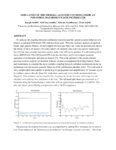TO
Filters: Collection: "ir_eua"
| Title | Date | Subject | Description | ||
|---|---|---|---|---|---|
| 226 |
 |
AJ_Colleges, Schools and Divisions | |||
| 227 |
 |
A chemical kinetics approach for heavy fuel oils gasification modelling | 2022 | surrogate; HFOs; pyrolysis; chemical kinetics modeling; Gassification | Refinery oil residue commonly considered the bottom of the barrel, can no longer be a waste. The increasing energy demand and the constant depletion of light oil supply make it crucial to find a suitable way to convert residual oils into valuable fuels. The gasification process represents a possible... |
| 228 |
 |
Geology of the bituminous sandstone deposits near Sunnyside, Carbon County, Utah | 1956 | geology; bituminous sandstone deposits; Sunnyside; stratigraphy; Wasatch formation; Green River formation; bitumen extraction | The bituminous sandstone deposits near Sunnyside, Carbon County, Utah, the largest known in the United States, were examined by the writers when employed by the Geological Survey, U. S. Department of the In- terior, as a collateral part of an investigation of sources of petroleum products. The ... |
| 229 |
 |
Modeling requirements in government decision making processes: a concept paper | 1976-01 | Over the past several years, several significant advances in the theory and practice of governmental contingency planning and decision making and in required economic modeling support systems have been developed in the Office of the Utah State Planning Coordinator. | |
| 230 |
 |
Process and apparatus for separating coarse sand particles and recovering bitumen from tar sands | 1978-10 | sharp separation from tar sands; tar sands; bitumen recovery; patent; solvent extraction | A system for effecting a sharp separation from tar sands of the large weight fraction of coarse materials present therein and for recovering bitumen, or tar, from the remaining product, wherein, as a first step, finely divided particles of a tar sand are added to a liquid hydrocarbon solvent in an a... |
| 231 |
 |
1955-56 General Catalog | 1955 | University of Utah catalogue; (Catalog) | Bulletin of the University of Utah, Volume 46, May, 1955, No. 4. Catalogue of the University of Utah. Announcement for 1955-56 |
| 232 |
 |
Clean and secure energy from domestic oil shale and oil sands resources: Quarterly progress report: January 2012 to March 2012 | 2012-04 | ICSE; University of Utah; Green River Basin; CO2 capture; Oil sands; Crude oil refining; International Flame Research Foundation; IFRF; Oil shale; Pyrolysis; Thermogravimetric analysis; TGA; TEA-C burner; Uinta Basin; Flameless oxy-gas process heaters; Efficient CO2 capture; Liquid Fuel Production ... | The Clean and Secure Energy from Domestic Oil Shale and Oil Sands Resources program is part of the research agenda of the Institute for Clean and Secure Energy (ICSE) at the University of Utah. In outreach efforts, ICSE participated in a session on oil sands at the Utah Governor's Annual Energy Deve... |
| 233 |
 |
In situ thermal processing of a coal formation using a controlled heating rate | 2004-06-15 | coal formation; in situ thermal process; in situ; thermal process; heating rate | A coal formation may be treated using an in situ thermal process. A mixture of hydrocarbons, H2, and/or other formation fluids may be produced from the formation. Heat may be applied to the formation to raise a temperature of a portion of the formation to a pyrolysis temperature. A heating rate to a... |
| 234 |
 |
Recovery and upgrading of oil from Utah tar sands | 1986-09-30 | Utah tar sands; bitumen upgrading; thermal recovery; fluidized bed retort; energy efficient heat pipe process; water-assisted separation of bitumen from ore | The University of Utah tar sands research and development program has progressed well in its second year of the current three-year contract. The program has advanced significantly toward its long-term objectives. The long-term objectives of this program remain the development of scientific and engin... |
| 235 |
 |
Required Documentation 1.2a(ii): Goal Achievement - SMART Goals | The University of Utah 2006 Self-Study Required Documentation: Standards 1-4. Standard 1: Institutional Mission and goals, Planning and Effectiveness. Part 2: Analysis and Appraisal of Outcomes. Section A(ii):Goal Achievement - SMART Goals | ||
| 236 |
 |
Quarterly Progress Report Phase II: Clean and Secure Energy from Coal Project Period October 1, 2009 to December 31, 2009 | 2010-01-30 | domestic coal resources; capture CO2 from combustion; stationary power generation; oxy-coal flames; one-dimensional turbulence; ODT. | On September 14, 2009, Modification #001 was executed to renew the project for an additional Budget Period as a result of FY-09 Congressional Direction and funding. As part of this modification, the project was re-aligned to support only NETL's Strategic Center for Coal (SCC) program moving forward.... |
| 237 |
 |
Standard 7: Instructional Staff | 2006-08-18 | The University of Utah in 1996: a report to the Commission on Colleges of the Northwest Association of Schools and Colleges. Standard 7: Instructional Staff | |
| 238 |
 |
UUSAC publications 1997-1998 | 1998 | University of Utah newsletter; publications | University of Utah newsletters including UUSAC News, Community Forum and FYI |
| 239 |
 |
Chemical looping combustion kinetics | 2009-12-01 | chemical looping; combustion kinetics; CO2 capture; coal-fired power plants; CLC | One of the most promising methods of capturing CO2 emitted by coal-fired power plants for subsequent sequestration is chemical looping combustion (CLC). A powdered metal oxide such as NiO transfers oxygen directly to a fuel in a fuel reactor at high temperatures with no air present. Heat, water, and... |
| 240 |
 |
Liberal Education | |||
| 241 |
 |
Final report--volume 2: Publications and presentations | 1986-12 | Cooperative Agreement DE-FC21-83FE60177; Western Research Institute (WRI); DOE programs; oil shale; tar sand; underground coal gasification; advance process technology (APT); asphalt; annual and quarterly reports | Volume 2 of the final report for Cooperative Agreement DE-FC21-83FE60177 lists the publications and presentations by Western Research Institute (WRI) researchers under that agreement. Entries in this list represent the four major U.S. Department of Energy (DOE) programs included in that agreement ... |
| 242 |
 |
Oxy-coal combustion studies - Task 3 topical report, Utah Clean Coal Program. | 2014-08 | oxy-coal combustion; Utah Clean Coal Program; oxy-coal; large eddy simulations; near-flame aerodynamics; pilot-scale oxy-CFB; single-particle oxy char oxidation; ash partitioning; carbon capture; pulverized coal-fired power plants | The objective of this task is to move toward the development of a predictive capability with quantified uncertainty bounds for pilot-scale, single-burner, oxy-coal operation. This validation research brings together multi-scale experimental measurements and computer simulations. The combination of s... |
| 243 |
 |
APPENDIX D - Meeting data needs to perform a water impact assessment for oil shale development in the Uinta and Piceance Basins, A subpart of project - Quantifying water availability impacts and protecting water quality while developing Utah oil shale and sands - Final Project Report - Reporting period: June 21, 2006 to October 21, 2009 | 2009-06-23 | Uinta Basin; Piceance Basins; Water impact assessments; Oil shale development | The goal of this project was to mitigate water resources impacts from oil shale development in the U.S. by compiling geospatial data and water use estimates to assess water availability impacts. |
| 244 |
 |
Investigative approach to address thermoacoustic vibration in gas-fired heaters and boilers | 2022 | Industrial gas-fired boilers, furnaces and heaters occasionally encounter low-frequency vibrations generated by dynamic feedback between the burner (or burners) and acoustic modes in adjacent cavities in the main combustion chamber or ductwork. Feedback occurs when pressure pulses associated with ac... | |
| 245 |
 |
Section 8 | |||
| 246 |
 |
Attachment 3--Statement of project objectives (mod 003) | 2009 | Project; Research; Tasks; Industry; Academic; Public outreach; ISCE; DOE; Department of Energy; Repository; Large Eddy Simulation; LES; ARCHES; Oxy-coal; DQMOM; Power generation; Retrofit; Gasification; Entrained-flow; Radiation modeling; In-situ fuel production; Mercury control | This material is based upon work supported by the Department of Energy under Award Number FC26-08NT0005015. C. Tasks to be performed (Phase 2) |
| 247 |
 |
Conversion of hydrocarbon gases to liquid in the fluidized bed retort | 1987-06-12 | A free radical steady-state mechanism has been developed to explain qualitative and quantitative aspects of the generation of hydrocarbon gases in the solid-recycle fluidized bed retort. The mechanism relies on what is known about butane cracking. The 1- and 2-butyl free radicals have been studied a... | |
| 248 |
 |
FT-IR and 1H NMR characterization of the products of an ethylene inverse diffusion flame | 2006 | ethylene inverse diffusion flame products; analysis of the chemical functional groups; FT-IR and 1H NMR | Knowledge of the chemical structure of young soot and its precursors is very useful in the understanding of the paths leading to soot particle inception. This paper presents analyses of the chemical functional groups, based on FT-IR and 1H NMR spectroscopy of the products obtained in an ethylene inv... |
| 249 |
 |
Simulation of the thermal-acoustic coupling inside an industrial hazardous waste incinerator | To analyze the coupling between combustion reactions and the natural acoustic behavior of a reactor, a transient LES based CFD code has been used. Previous transient analysis of ignition inside large process heaters, of multi-tipped elevated gas flares and waste incinerators has shown the ability of... | ||
| 250 |
 |
U.S. tar sand oil recovery projects (1982) | 1982-02 | U.S. tar sand; oil recovery; energy demand; conventional petroleum decrease; less conventional energy sources; tar sand resource | As the demand for energy in the United States increases and the reserves of conventional petroleum decrease, the interest in development of less conventional energy sources is increasing dramatically. This interest, plus the recent decontrol of crude oil prices, has resulted in widespread activities... |
